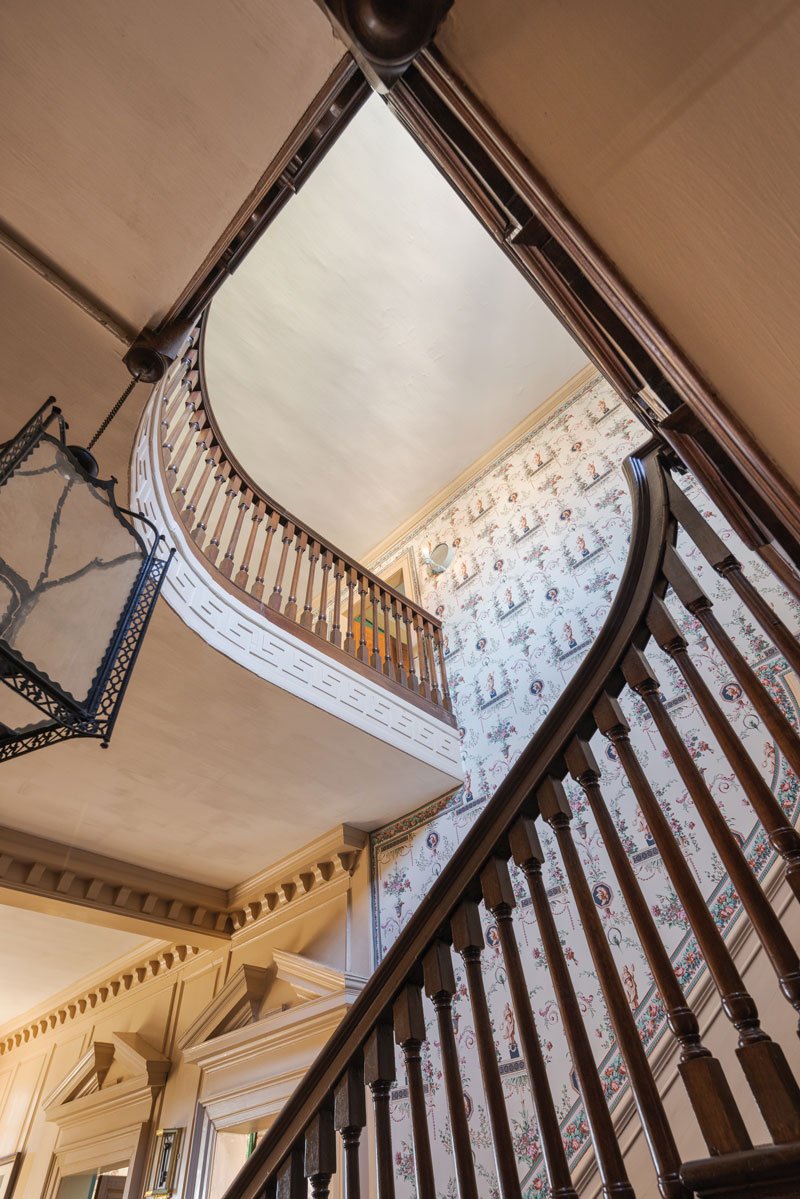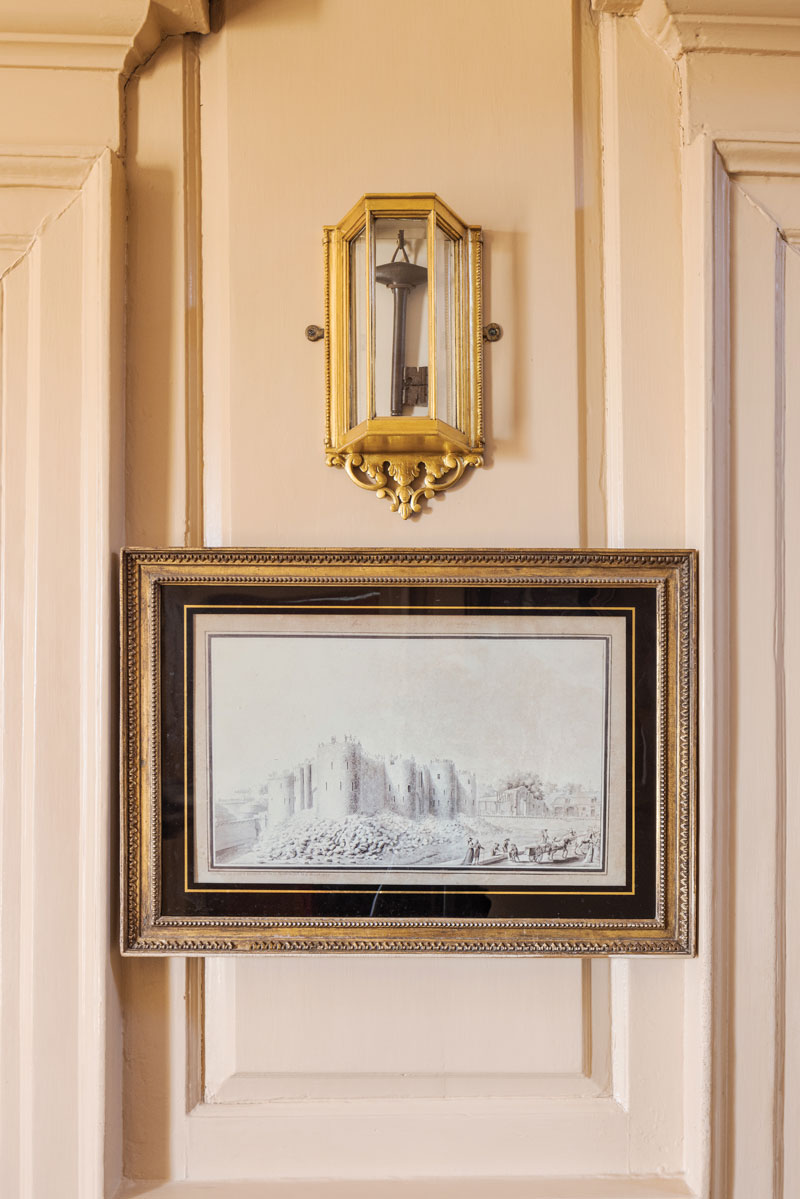
Adam T. Erby is Mount Vernon’s curator of fine and decorative arts, specializing in historical interiors, 18th-century furniture, and American art. He most recently led the refurnishing and reinterpretation of the Mansion’s Front Parlor and the installation of the permanent exhibition Mount Vernon: The Story of an American Icon.
Header Image by Dan Chung
The multiyear restoration of the Mansion’s Central Passage edges closer to completion
Serving as the main entrance to the Mount Vernon Mansion for much of its existence, the Central Passage was, in many ways, the heart of the house. The space contains the Mansion’s main staircase and stretches its full depth, providing access to all of the rooms in the core of the Mansion. During George and Martha Washington’s final years, guests would arrive at the front door, where Frank Lee, the enslaved butler, greeted them. As was the custom of the period, the passage served as the main filtering point in the Mansion, as Lee determined who waited for the Washingtons and whom he conducted directly to the Front Parlor. The room also served as a space for living and dining during hot summer months, when open doors at each end created a cross breeze, making this the coolest location in the house.
In 2015, the preservation and curatorial teams embarked on a multiyear research and restoration project of the Central Passage, utilizing the latest documentary evidence, paint analysis, and the latest expertise to present its appearance in 1799. As a result of this work, visitors today experience a brighter, airier space, enlivened by numerous architectural and artistic references to Roman antiquity.
Classical Architectural Details
George Washington directed the creation of the space we know today as the Central Passage between 1757 and the early 1760s, as he expanded his father’s house to two full stories and wed Martha Dandridge Custis. Drawing upon popular English pattern books, such as Batty Langley’s The City and Country Builder’s and Workman’s Treasury of Designs, that translated the works of the ancient Roman architect Vitruvius for 18th-century audiences, Washington infused the Central Passage with classical taste. In step with elite Tidewater planters, the young Virginia colonel planned a grand entryway to his mansion, with some of the most elaborate classical architectural ornamentation in the house. For the west entrance, Washington chose an exterior door surround (the decorative frame around a doorway) with columns in the Tuscan order. Inside, he replaced his father’s small, old-fashioned stairway with a wide and elaborate staircase with a black walnut balustrade, yellow pine treads and risers, and decorative nosings and brackets. Each
baluster was turned in the shape of an attenuated column. This staircase became the centerpiece of the room. At the same time, Washington had the room wood-paneled, an elaborate treatment reserved for the most important spaces at Mount Vernon. Above the interior door surrounds, he installed classically inspired broken pediments, initially intended to be filled with busts of famous leaders, including Julius Caesar.
Paint and Paper
As part of the current restoration campaign, the preservation team conducted new paint analysis to help determine the color of the woodwork. Enhancements in technology since the previous paint analysis in 1980 made it possible to discern numerous layers of paint that had not previously been recognized. Paint conservator Susan Buck, Ph.D., of Williamsburg, Virginia, identified seven early layers of tan to cream-colored paint, colors the Washingtons would have called “stone,” imitating the stone buildings of classical antiquity. The documentary record indicates that the Washingtons redecorated the Central Passage approximately once every 10 years, pointing to the fourth layer as the likely final coating applied during the Washingtons’ lives. By contrast, the previously replicated graining layer was the eighth, which post-dated the Washingtons.

A classical goddess, graceful swags, and curling
arabesques distinguish the elegant wallpaper pattern. (Above)
The banister of George Washington’s impressive staircase is made from native black walnut he had shipped back from his 1758 military campaigns in the Ohio River Valley.
Photos by Dan Chung

Rather than panel the entire height of the wall ascending the staircase, Washington chose to plaster the wall above the chair rail, leaving room for wallpaper, a common decorative feature in passages. Curators reexamined several fragments found by Colonel Harrison Howell Dodge in 1898, concluding that this paper likely dated to the neoclassical period (1790–1810). The largest fragment features a scrolling leaf design, a pattern found almost exclusively on arabesque papers and one often used in formal passages.
Inspired by ancient Roman wall paintings uncovered in the buried cities of Herculaneum and Pompeii, and published beginning in the 1750s, arabesque wallpapers featured repeating designs arranged along a central axis. The French were best known for their arabesque designs, and the most classical often featured ancient gods and goddesses, urns, flowers, and vines. Unfortunately, the small fragments found by Dodge did not provide enough information to replicate the specific Washington pattern.
At New York’s Metropolitan Museum of Art, curators located a documented arabesque paper, acquired in the early 20th century from the Allentown, New Jersey, home of John Imlay, a wealthy West Indian merchant. Remarkably, this paper survives with its original 1794 receipt from Philadelphia paper stainer William Poyntell, the same merchant the Washingtons patronized three years later as they prepared to return to Mount Vernon from the presidency. Poyntell was one of the most prominent paper stainers in Philadelphia, advertising that he had “for sale twelve thousand pieces of French papers, together with Borders, Landscapes and Chinese Pieces” in addition to an “extensive stock of his own manufacture.” Although the Imlay house pattern is not an exact match for the Washingtons’ paper, it is one they could have purchased.
Adelphi Paper Hangings of Sharon Springs, New York, undertook the task of re-creating Imlay’s elaborate and expensive French paper in the 18th-century manner. The wallpaper required 22 wooden printing blocks, one for each color, divided into two repeats of 11 each. The company utilized modern laser engraving to carve the wooden blocks, but it printed each color by hand, as artisans would have done in the period. The design of the paper features a typical arabesque mixture of a vase with flowers and a classical figure holding a laurel wreath and an urn, along with the more unusual features of a parrot and a bust of the Roman god Mars in profile. Adelphi also re-created Imlay’s “narrow rose border” for use at the cornice and chair rail.


Washington installed a decorative Greek key pattern at the base of the second-floor railing. At the foot of the staircase is one of Mount Vernon’s most treasured objects (opposite), the original key to the main door of the Bastille.
Photos by Dan Chung
On the Walls
Like the dining room, Front Parlor, and New Room, the Central Passage served as a public space, and the Washingtons’ artworks intentionally conveyed specific messages to their guests. By 1799, the room was filled with art largely acquired in 1797, the last year of George Washington’s presidency. Thus, the Central Passage, like many other rooms in the house, was a careful construction from the last years of Washington’s life. The three principal decorative features were the key to the Bastille and its accompanying drawing, a John Trumbull print of George Washington at the Battle of Trenton, and a number of classical and landscape engravings.
Placed between the doors to the dining room and the downstairs bedchamber, the Bastille key and drawing occupy the most prominent location in the passage. The Marquis de Lafayette sent the “Main Kea to the fortress of despotism” to George Washington in 1790, just after the infamous French prison fell. For more than 200 years, the key has hung in the same location, offering a vivid reminder to all guests that Washington and the American Revolution sparked a globe-spanning movement toward liberty. Conservation of the key’s original case included re-creating a missing carved element of the base, repainting the interior its original color, and reversibly regilding the exterior to return it to its intended shine. Below the case is a new digital reproduction of the light-sensitive original drawing. Sketched by the demolition architect, it shows the “Bastille just as it looked a few days after [Lafayette] had ordered its demolition,” with small figures atop the walls tearing down the prison.
At the time of Washington’s death, the large engraving of George Washington at Trenton was by far the most valuable object hanging in the Central Passage. The artist was particularly proud of this image, for which Washington sat in 1790. Trumbull, who had served briefly as a military aide to the General, sent Martha Washington a proof of the engraving in 1797, and she valued it so highly that she bequeathed it to her granddaughter Martha Parke Custis Peter. The original survives today, still in the elaborate gilt frame and glass mat likely ordered by Mrs. Washington, at Tudor Place Historic House and Garden, the Peter family home in Georgetown, Washington, D.C. (Mount Vernon is grateful for permission to replicate the original frame to display this image.)
To complete the artwork installation along the walls of the first floor and up the stairs, the Washingtons hung 10 additional gilt-framed prints: a set of Trumbull’s engravings of The Battle of Bunker Hill and The Death of General Montgomery, and eight engravings of classical and landscape scenes. Selected from dozens of prints Washington had purchased before leaving Philadelphia in 1797, these scenes included popular mythological subjects, such as Adonis Carried off by Venus, and prospects of ancient ruins, such as A View of the River Po in Italy. The prints were stock images sold by the largest London printseller at the time, John Boydell, and were greatly valued for the skill required to create the printing plates. The engravings were similar to others hung in Mount Vernon’s bedchambers, indicating the Washingtons’ knowledge of art and their learned interest in arcadia and the classical world.
The space above the east door in the Central Passage is often overlooked by modern visitors, but during the Washingtons’ lives it served as a focal point for guests arriving through the west door. George Washington’s probate inventory recorded “4 Images over the door.” Two of these “images,” actually small sculptures, had been purchased through his London business agents in 1759, referenced in the invoice as “Two Lyons after the Antique Lyons of Italy.” Washington’s original pair, copies of the ancient Roman marble lions at Florence’s Villa Medici, survive today and have returned to their original locations, thanks to a long-term loan from the Yale University Art Gallery. The other two sculptures remain something of a mystery, but one was likely the “bust of [William] Shakespr” that George Washington purchased in 1774 from the sale of goods at Belvoir, the home of George William and Sally Fairfax. The curatorial team continues to search for an appropriate bust of Shakespeare to place above the door.
As the heart of the home, the Central Passage invites today’s visitors to experience what George and Martha Washington valued and wanted their guests to experience, through their choice of wall finishes, artwork, and treasured gifts. From the neoclassical motifs of the wallpaper to the gilt-framed scenes of the American Revolution and classical mythology to the Bastille key in its glass case, the furnishings of the Central Passage celebrated the ancient roots of the new republic’s revolutionary ideals.

The colorful neoclassical wallpaper frames the view out the west window in the upper level of the Central Passage. (Above). Photo by Sierra Medellin
George Washington received this pair of plaster lions from London in 1759 and installed them in the space above the east door. (Below) courtesy of Yale University Art Gallery, de Lancey Kountze Collection, Gift of de Lancey Kountze, B.A. 1899, Photo by Mark Finkenstaedt
